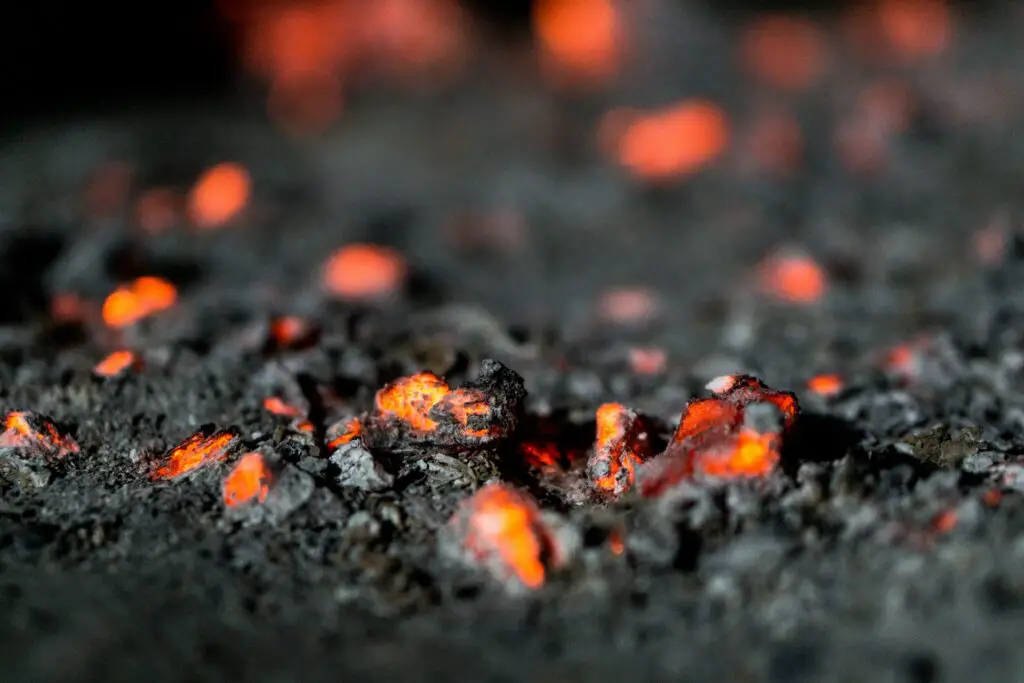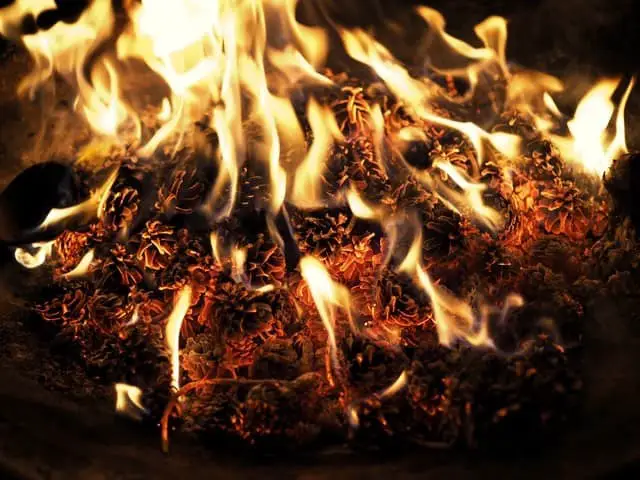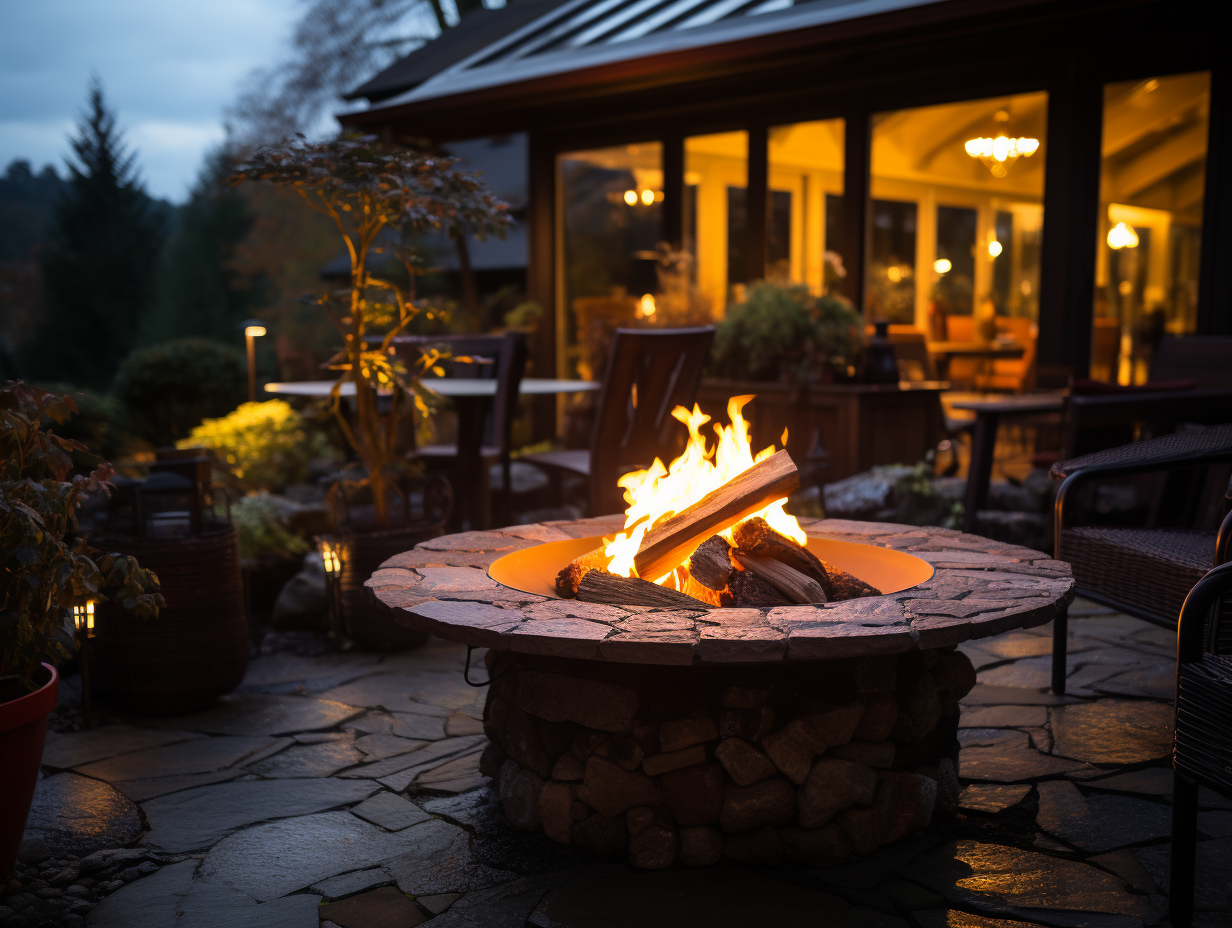
There are many ways to dispose of ashes from a fire pit. You can compost them, spread them on your garden or flowerbeds, use the ashes as mulch for your plants as nutrients.
If you want an eco-friendly way to get rid of these ashes, we recommend that you use one of those methods!
The first thing that comes to mind when a fire pit is mentioned is a campfire, but a fire pit can also be used in your backyard. The ashes from these fires often need to be disposed of and the best way to do this varies depending on where you live.
In some areas, it’s required by law for householders to bury their ashes within 24 hours. In other areas, there are no regulations at all about disposing of firepit ash.
This is a blog post about what to do with ashes from your fire pit. I will talk about how to avoid making mistakes when deciding where to put them, and also the best way to dispose of ashes so you don’t get in trouble.
I think it’s important for people who live in areas with strict laws on disposal of ash to know how they can handle their fire pit remains responsibly.
What To Do With Ashes From A Fire Pit?
A fire pit is a great way to have an outdoor gathering with friends and family. The firepit will provide warmth, light, and entertainment for everyone in attendance.
However, when the party is over you are faced with ashes from the fire pit that needs to be dealt with.
What should you do with old fire pit ashes? Here are 11 tips on what to do with ashes from your fire pit:
I Found This Great Ash Bucket With Lid HERE
1. Garden Fertilizer
The most common use for wood ash is used as a fertilizer for plants. It can help to neutralize soil that has excess acidity so this is something you might want to consider if your garden tends towards being too acidic.
Wood ash also contains potassium which will add nutrients back into the soil when it decomposes over time.
Just keep in mind, however, that wood ash does have a lot of salt content and care should be taken not to use too much at one time because the sodium could harm tender seedlings or young plants just beginning to grow.
Acidic soils are more susceptible to leaching heavy metals like aluminum into groundwater supplies. Some also believe that an increased pH level is harmful to certain plants, but the evidence behind these claims is inconclusive at best.
Highly acidic soil can inhibit the uptake of certain metallic nutrients that plants need to survive, but this effect is seemingly only seen in extreme cases where the pH levels get up to 10 or 11. In most cases, a little bit of wood ash will have no noticeable impact on plant growth.
Tests have been done with various vegetables and trees growing in soils with varying amounts of wood ash added, and both types of plants seemed to grow equally as well in soils with a relatively high amount of wood ash compared to lower concentrations.
2. Cleaning Material
Ash, when utilized correctly, can also be a component that assists you in cleaning the surfaces of metals and glass.
People combine wooden ashes with water to form a paste that is slightly abrasive and may clean up glass or tarnished metal surfaces.
If you decide to make your own ash-based paste and use it to clean the surface of your glass or metal, it is important to be sure you only use the ashes from a fire that has burnt wood.
3. Make Soap
Wood ash can be used in a number of different ways, including making your own soap. After burning wood in a fire pit or outdoor fireplace for an extended time period, you will have a large number of ashes remaining over the top and sides.
The first soaps were made using water and dried lye as a base. Ashes of burned hardwoods contain enough potassium as necessary to produce lye necessary for the making of soap.
These ashes are the perfect ingredient to make your own soap.
Wood ash is rich in lye, which makes it a great natural cleanser and degreaser. It also has many other benefits for skincare including being able to treat acne, rashes and help soothe sunburns.
4. Bug Repellent
One of the most common uses for wood ashes is as a natural pesticide. Mixing about one part ash one part of lime with 2 gallons of water makes an effective insecticide that you can spray on top of your plants that kills aphids and chewing insects such as beetles, grasshoppers, and even ticks.
You can also sprinkle the wood ashes around infected areas. Use a ratio of roughly one cup per square yard in your garden beds.
Keep in mind that this method does not work on contact, so you will have to reapply it after rain or watering your plants.
5. Traction In Snow
Wood ash may also be used as traction in the snow. You’ll use it the same way you would gravel. Sprinkle it along the path that has been snowed upon.
This will allow you to have more traction over ice patches. As a result, you could want to keep a small bucket of ash in your car for this purpose.
6. Clean Up Spills
Wood ash is an inexpensive and natural way to remove spilled liquids from carpets or oil from other surfaces like concrete or asphalt.
Mixing wood ash with water forms a paste that uses the alkalinity of the ashes to lift up spills, while any excess can be vacuumed away.
Sprinkle the ashes over a liquid stain, allow it to absorb the oil for several hours, then sweep the ash away with a broom.
7. Absorb Odor
Many people use baking soda for this purpose as well, but keep in mind that baking soda only absorbs smells rather than lifting them up as wood ash does.
Wood ash also contains trace amounts of calcium carbonate which neutralizes acidic odors such as urine stains on carpeting and makes it easier to get rid of these types of pet accidents without having lingering smells around your home.
8. Polish Metal
Because it is a mild abrasive, wood ash may be used to polish silver and other metals when combined with a little water to form a paste.
Wood ash can also be rubbed on leather to make it shine.
9. Stop Algae Growth
Wood ash won’t kill algae on its own, but it can help to manage it. Because wood ash is so rich in potassium, sprinkling it into a pond will encourage the other plants to develop and compete with the algae, keeping it in check.
10. Deter Ants
Have ants taken over your grass? Sprinkle a layer of wood ash on the ant mounds to force them to move.
11. Fire Extinguisher
Finally, you may use ash to make an air-tight barrier that you can use in the extinguishing of fires.
Of course, you’d need a lot of ash to put out a large fire, but you might just have enough to douse a campfire. If you don’t have access to a fire extinguisher or similar material, ash can be used for this purpose.

How Do You Dispose Of Fire Pit Ashes?
With a fire pit, you can enjoy the pleasure of having fires without worrying about getting ashes everywhere. But if you do not know how to properly dispose of your fire pit ash there is going to be a mess for you to clean up.
We recommend the following steps for proper ash or coal disposal: Allow ashes and coals to cool in the region where you had the fire for several days if possible.
These fire pits and fireplaces are built to keep heat confined. Transfer the ashes to a metal container with a metal shovel or scoop and dampen the ash down with water.
Is Fire Pit Ash Good For Garden Fertilizer?
Yes, wood ash is great for garden fertilizer because it is high in calcium, magnesium, and potassium, among other essential minerals.
Wood ash can be used to a minor extent in gardens, thinly distributed over grasses and thoroughly mixed into compost heaps.
Wood ash is beneficial to lawns requiring lime or potassium since it contains 10-15 pounds of material for every 1,000 square feet (50 kg/m2).
I personally love using fire pit ash as a fertilizer for my garden. It works great!
- The nutrients in the ash are beneficial to plants and help them grow strong roots, stems, leaves or flowers.
- You can spread out your ashes around your flower beds or vegetable gardens after you use up all of the logs from the original burn (or if you don’t need it anymore). Just make sure not to let it pile up too much because rain will wash away any excess nutrients that haven’t gotten into the soil yet.
- If you have an area without grass then just take some leftover ashes and mix with potting soil to create nutrient rich dirt perfect for starting seeds indoors. Planting inside will give your plants a head start on the growing season.
Is Wood Ash Good for Grass?
Yes, wood ash is a great way to balance the pH of the soil and provide additional nutrients. The key here though is moderation as too much can cause more harm than good.
Benefits of Wood Ashes: The soils that have been depleted from repeated use and fertilizer can benefit from the nutrients contained in wood ashes.
This is especially true for acid-loving plants such as azaleas, blueberries, camellias, gardenias, laurels, and rhododendrons.
Wood ash contains a variety of elements including calcium carbonate (which helps neutralize acidic soil), potassium hydroxide (used to lower high pH levels), and magnesium oxide which decreases soil compaction allowing air space between particles for roots to grow freely without being constricted by tight clay soils.
It also provides phosphorus needed for seed germination plus important trace minerals iron manganese zinc copper boron silica nickel cobalt and others that are helpful to soil structure, root development as well as plant disease resistance.
In fact, there may be a few instances where wood ash is not good for your grass or it could even damage the lawn if used incorrectly.
If you have alkaline soils (above pH of seven) then adding more wood ashes will increase this effect which can cause problems with certain types of grasses such as bentgrass, bermudagrass fescue bluegrass ryegrass zoysia St. Augustine centipedegrass buffalo grass kikuyugrass sandplain gerardgras, etc.
The same goes for areas where heavy metal contamination exists in the topsoil from industrial or commercial activities where you have a high pH and low calcium level.
Avoid using wood ash during the winter months when the grass is dormant as it will not be able to utilize its beneficial nutrients at this time of year.
In addition, avoid adding too much during the growing season in sunny areas with thin soil because it can lead to burning which could cause browning, discoloration, yellowing, scorching, or your grass to die depending on how bad your problem may be if burned beyond recovery.
Is Are Fire Pit Ashes Good For Anything?
Yes, there are several things you can do with fire pit ashes.
- Garden Fertilizer
- Cleaning Materials
- Make Soap
- Use It As A Bug Repellant
- Traction For Icy Surfaces
- Use It To Clean Up Spills
- Use It To Absorbs Odors
- Use It To Extinguish Fires
- Deter Ants
- Stop Algae From Growing
- Polish Metal
I Found This Great Ash Bucket With Lid HERE
How do you Safely Remove Fire Pit Ashes?
The best way to safely remove your fire pit ashes is by using a metal ash bucket that has a handle and spout.
You can also use a dustpan with a long-handled brush attached. Use these tools to scoop up the ashes, then pour them into an outdoor garbage bin or on-site bag for disposal in the local landfill site.
Avoid using plastic bags to hold the ashes as they are not biodegradable and can take many years — even hundreds of years — to decompose.
Where Should I Dump Ash From A Fire Pit?
When you are ready to dispose of wood ashes, keep them in a METAL container until they have cooled. Place cooled ashes in a combustible container (such as a box or bag) on your regular garbage collection day.
Use extra caution when transferring cooled ashes to a combustible container.
Ash from a fire pit should only be deposited in the general waste bin. Small amounts of ash from wood may be put in your home composter.
If you have a fire pit in your backyard, or at the beach then it is essential that you know where to dump ash from a fire pit. If not disposed of properly, ashes can cause health problems for people and animals living nearby.
Do I have To Remove Ashes From A Fire Pit?
Yes, ash should be removed when the accumulation of ash reaches beyond an inch. Ash is acidic in nature and can pit the bottom of your fire pit or fireplace if left too long.
In addition, excessive ash may prevent you from successfully lighting a fire.
When your fireplace or fire pit is used frequently, ash should be removed at least every other week.
If you don’t use the fireplace often and only need it for special occasions (like holidays), then remove and clean out the ashes when necessary – which could range anywhere from once a month to three times per year depending on how much usage.
Use this guide as a general reference: if there’s less than an inch of accumulated ash, leave it alone; up to two inches means that it may be time to get rid of some of that ash.
Can You Flush Wood Ashes Down The Toilet?
You should never flush them down the toilet though. They will harden over time which could lead to a clog.
How Long Do Fire Pit Ashes Stay Hot?
Fire pit ashes typically last for a few days depending on conditions. The hotter the fire, the more completely it will burn and the longer your ash should stay hot!
If you’re going to reuse them as fertilizer or compost ingredients, be sure they’ve cooled down before adding them to your garden soil.

![What Gravel To Use For Patio Base [Best Options]](https://www.cleverpatio.com/wp-content/uploads/2021/11/What-Gravel-To-Use-For-Patio-Base-270x180.jpg)


Leave a Reply